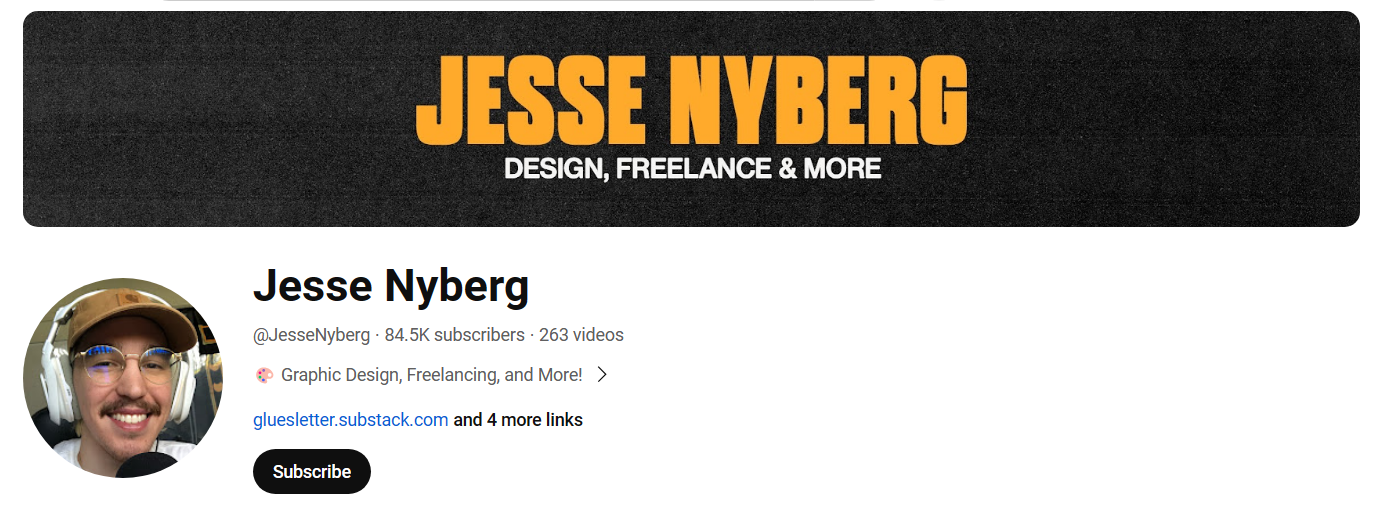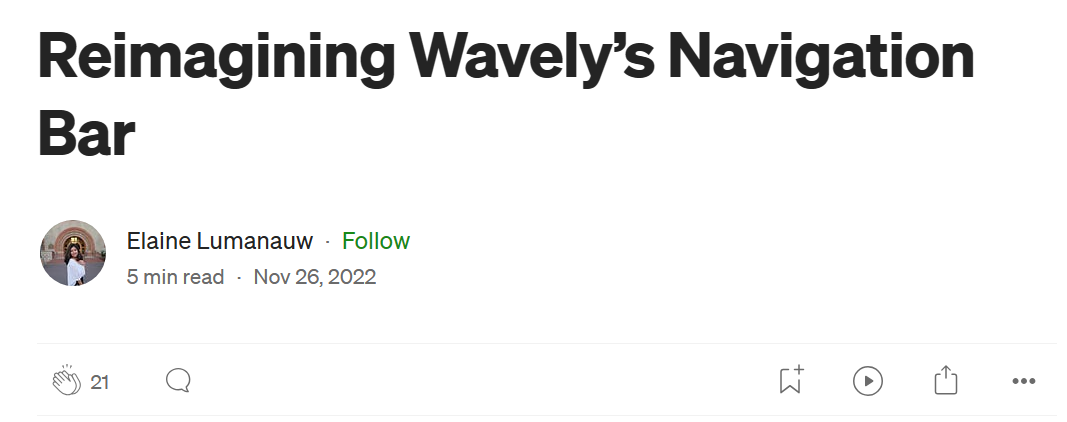Ready to build a portfolio that wins a job you love?
LinkedIn, resumes, cover letters… These are all legit resources that can help you win a new job.
The problem? Every single candidate is resorting to them.
So, how do you set yourself aside?
The answer is: by building a portfolio.
A portfolio is the best way to showcase your work and the results you have achieved.
Why? Because you are delivering real, tangible samples of your work.
In this article, I'll explain how you can build one in 7 steps, then walk through some real-life portfolio examples. After that, I'll share some of my top portfolio website picks.
Here's our table of contents in case you want to jump into specific sections of this article:
- Who Should Leverage The Portfolio Strategy (Hint: It's Not Just For Designers And Creatives)
- How To Create A Portfolio For A Job In 7 Steps
- Professional Online Portfolio Examples
- Best Portfolio Websites To Build Your Own
- Ready To Turn Your Portfolio Into A Job-Winning Machine?
Let's get started!
Who Should Leverage The Portfolio Strategy (Hint: It's Not Just For Designers And Creatives)
Some people think they can't build a portfolio because their work isn't “tangible” enough. In other words, they are not creating something.
And I get it. I mean, how do you build a portfolio when you are, let's say, a Financial Manager who spends most days crunching numbers? Or an HR Manager focused on employee development?
I know portfolios are often associated with designers and creatives. But the truth is anyone can leverage a portfolio, as long as they have:
- Case studies: And I'm not talking of a case you took ownership of. You can build cases around companies you would like to work for, inspiring projects you love, institutions you admire… the list goes on!
- A platform to show your work: It can be LinkedIn, Medium, YouTube…
Stick with me in this next section and I'll walk you through the step-by-step guide to building a job-winning portfolio, no matter the role you are aiming for!
How To Create A Portfolio For A Job In 7 Steps
A portfolio is a collection of your work that proves your worth to employers.
Now, some people choose the traditional PDF file, but we'll be taking a different approach.
You will want to focus on a portfolio that not only showcases your talent and skills but also walks through your process. This way, you're showing employers more than simply the outcomes of your work. You're showing them how you think.
The first step you'll take to build your portfolio is:
#1 Choose Your Content Format & Platform
First, choose the type of content you will want to create to share your work. Will you…
- Write?
- Design?
- Create a video?
Once you've decided on the format, then it's time to choose the place where you'll host your content.
Sure a neatly designed ebook in a PDF file can do the trick for most portfolios. But If you really want to show your worth, be sure you pick a platform that:
- Allows you to create the way you want: Choose a platform where you can leverage tools and resources that add more value to your work.
- Maximizes your visibility: Your best pick will be a platform where others can engage through reactions and comments.
For example, let's say you want to build a content writing portfolio.
Building your website can give you the flexibility to write as you please. On the other hand, you might struggle to increase your visibility. In this case, I'd suggest a platform like Medium, where you can write, format, and add different media easily. Plus, you can build a following and interact with other writers, too!
#2 Identify Your Target Companies
Next, brainstorm your list of 3-5 target companies. You're going to be researching them and creating value that's directly tied to their goals, challenges, and vision. Bonus points if they're in the same industry.
#3 Align Your Projects
Start with one company. Research the heck out of it from a high level, then dive deeper into researching the specific product and team you're targeting.
Your goal is to identify:
- Goals
- Challenges
- Initiatives
Learn as much as you can about them. Then, start crafting projects that align with their needs.
For example:
If you are a Graphic Designer, you can refresh the branding for your favorite products.
If you are a Marketer, you can perform site audits and recommend 3 ways for companies to get more leads.
If you are a Software Engineer, you can QA your favorite apps and tools to identify bugs or improvements.
Next, you'll be ready to…
#4 Map Out The Process
Now that you've done the work, it's time to outline your story. Start with your methodology: why did you pick this specific company or product?
Then, break down your research, brainstorming, and solution process.
And don't forget: you don't want to just summarize your case; you want to sell it. You can add more value to it if you bring in information like:
- Reputable data from solid sources
- Project outcomes
- Client testimonials (sometimes even a comment section can do the trick!)
- News pieces
- ROI (if you can)
- And so on!
Once you've gathered and organized all of that information, you'll be ready to…
#5 Show Your Work
In other words: turn that process into content! Write up a “case study” showing:
- The problem/opportunity and how you identified it
- Your solution and how you came up with it
- The process for implementing your solution
When it's ready, hit publish and…
#6 Share Your Work
Now your case study is out in the world! Here's how you can work on your content's distribution:
- First, add it to your LinkedIn featured section: Simply follow the steps in this tutorial.
- Next, break it down into bite-sized pieces of content: You can write posts around the research process, the solution process, the insights you came across, and so on!
Then, your final step is:
#7 Systematize It
This works best when you consistently work at it. Create a daily schedule and commit to it!
Professional Online Portfolio Examples
Okay, now that we've covered the step-by-step, it's time to get in some specific examples to get inspired!
For this section, I've gathered some of the best portfolios I could find when it comes to selling the work. And the reason is, you'll probably find hundreds, thousands of amazing portfolios that focus on the work itself.
But I want to show you examples of people who not only show the work but also walk through their processes, analysis, and outcomes…in other words, people who have successfully built case studies around their expertise.
Let's dive in!
Graphic Design Portfolio Examples
Graphic design portfolios aren't hard to find. Behance and Dribbble are two platforms that host thousands of amazing design works. But, like I said, our goal here is to find people who share amazing content around their work.
Graphic Design Portfolio Example #1:
For that matter, we have Jesse Nyberg.
Jesse Nyberg is a freelance graphic designer. His YouTube channel with 84K+ subscribers aims to teach, learn, and chat about graphic design, art, freelancing, and creativity.
Not only is Jesse sharing his amazing work, but he is also building case studies around them — as perfectly illustrated in this video.
Graphic Design Portfolio Example #2:
Miroslav Novohradsky uses a different approach to share his knowledge in graphic design. His Medium profile with 2.2K+ followers shares content around combining AI tools and design skills to sell digital art.
This awesome piece he published in Design Nexus breaks down his process to the “100 design rule”, a technique that helps designers build a successful print-on-demand business. Another great example of how you can build a case study around your work!
Marketing Portfolio Examples
Marketing is all about telling stories. So there's no better way to do this than by writing them down.
When building a marketing portfolio, you can leverage content writing to build successful case studies.
This takes us to our first example:
Marketing Portfolio Example #1:
Teodora Maksimova uses Medium to share her thoughts on marketing and writing with her 1.6K followers.
Teodora wrote this amazing piece on how Apple mastered a 100-year-old strategy to sell the unibody MacBook Pro back in 2009. A great example of how to build a case study for a huge company!
Marketing Portfolio Example #2:
There's really no better way for a Social Media Marketer to prove their value than through social media. That's what Devendra Mani is doing. He uses Instagram to share his knowledge with a 52K+ audience.
Devendra shares awesome tips (like this one) about social media strategies and content creation. Not only is he building a solid portfolio to showcase his expertise, but he's also helping tons of marketers out there with his valuable insights!
Marketing Portfolio Example #3:
Callum Birch uses Substack to share the processes, mistakes, and lessons he's learned building marketing systems.
This post shows how he's identified an opportunity for Kajabi to produce ~$286,560 monthly revenue and breaks down his strategy to exploit this opportunity by investing the minimum of investing time, energy, and capital. This is an amazing example of how marketers can prove to employers how they will generate business through simple, yet effective strategies.
All these cases are great examples of how marketers can show their worth — from copywriters to social media managers, content strategists, and even UGCs!
Software Engineer Portfolio Examples
How do you build a portfolio when you are a software engineer?
The answer is simpler than you think. Like the examples above, tech professionals can also leverage platforms like YouTube, Medium, and even social media to showcase their work.
Which brings us to our first example:
Software Engineer Portfolio Example #1:
Nick Chapsas shares his knowledge in software engineering for a 274K+ audience on his YouTube Channel.
Nick has been teaching C# and .NET on YouTube while working for an employer. It was only in 2022 that he decided to work full-time as an educator and content creator. If you go back to his oldest videos on YouTube, you'll find that he's been making tutorials since the very beginning — a great way to share his knowledge and help fellow developers.
Software Engineer Portfolio Example #2:
Attila Vágó s a staff software engineer and tech writer who uses Medium to write about tech, software development, accessibility, and more for a 10.7K+ audience.
Attila shares great tips on software engineering (like in this post), but he also makes awesome reviews on LEGO and Apple products (as seen here and here). Both are great ways to show your worth — and another side of your personality, too!
Product Designer Portfolio Examples
Are you a product designer who wants to expand your portfolio but is out of products to design?
Don't let that be an issue. Here are two examples of product designers who built amazing portfolios by redesigning a product they love.
Product Designer Portfolio Example #1:
If you look into Kelley Nguyen's Medium profile, you will find only two articles. And they are both masterpieces when it comes to building a solid portfolio. In fact, her first publish has 2.1K claps on Medium and 50+ comments:
Kelley put all the work into one fantastic piece, breaking down each step of the redesign process, and bringing in thorough research packed with data. Definitely checks all the boxes on the “Do's” portfolio list!
Product Designer Portfolio Example #2:
Elaine Lumanauw took a similar approach, but using a case she worked on for her employer:
Elaine brought in the context and broke down all of the redesign process, from the investigation to the final design and development. Plus, she also brought in measurable results and the next steps. Awesome work!
Best Portfolio Websites To Build Your Own
Looking for platforms to host your portfolio? Here are a few of my top picks!
#1 Social Media Platforms
Social media platforms like LinkedIn, YouTube, Instagram, Pinterest, and so on can be great tools to showcase your work. Just take the examples shown above. Not only are they great for hosting content, but they also increase visibility and allow you to build a following.
Heck, maybe you'll even get to the point where you've grown an audience so big that you'll be able to generate a side income. Think about it!
#2 Medium
Medium is a great tool for creating content. You can write long-form pieces of content and also interact with other writers.
Plus, what I love about Medium is it allows you to seamlessly publish neat, aesthetically-formatted content, as it offers tons of resources!
#3 Behance
Behance is a platform where graphic designers, artists, illustrators, photographers, and UX/UI professionals can share their work.
Other users can engage with the work by liking the project, increasing visibility.
#4 GitHub
GitHub is a platform where developers can create, store, manage, and share their code.
Web developers, software engineers, and tech professionals can share their work and connect with others.
Once you've consistently dedicated yourself to building a solid portfolio, you'll have a body of work that includes real results and clearly illustrates your value.
That’s going to get you hired!
Ready To Turn Your Portfolio Into A Job-Winning Machine?
Then ramp up your portfolio strategy by creating a Value Validation Project.
A Value Validation Project (VVP) is a deliverable that benefits an influential contact at the company you want to work for. There are tons of ways you can build one, and this VVP Starter Kit can get you on track. Get instant access to proven guidance, templates, and examples you need to create a job-winning Value Validation Project!





































